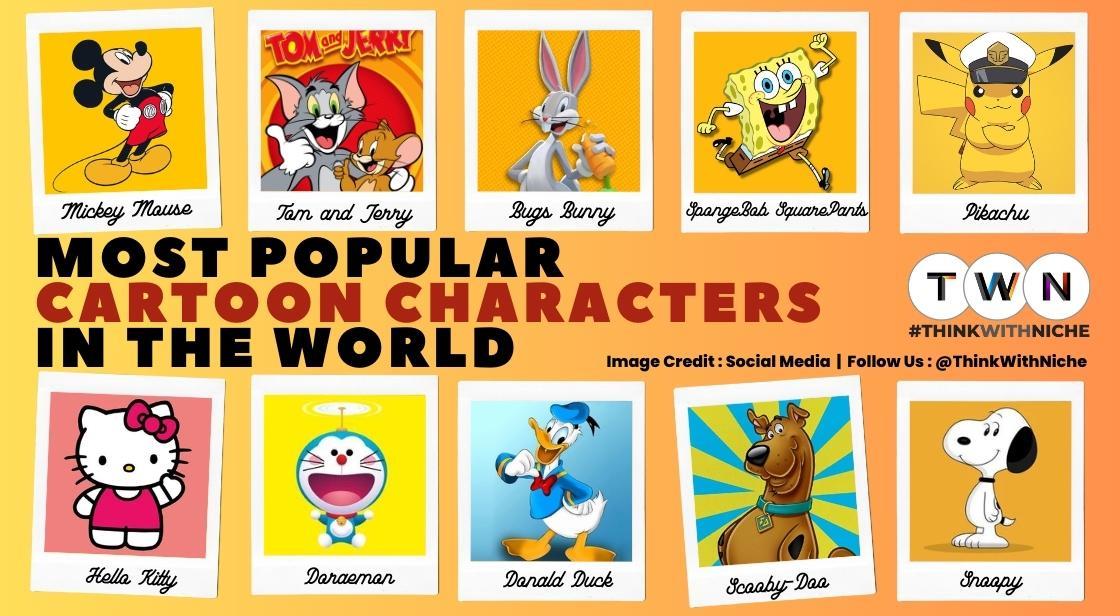Most Popular Cartoon Characters in the world

Blog Post
Cartoon characters have been an important part of popular culture for many decades, entertaining and enchanting audiences of all ages. The early years of animation saw the rise of beloved characters such as Felix the Cat and Betty Boop. However, it was Walt Disney's creation of Mickey Mouse in 1928 that paved the way for a new era of cartoon characters.
With his charming personality and mischievous antics, Mickey Mouse quickly became a household name and an enduring icon of the medium. Since then, numerous other cartoon characters have captured the hearts of audiences worldwide, from classic duos like Tom and Jerry and Bugs Bunny, to newer favorites like SpongeBob SquarePants and Pikachu. These beloved characters continue to entertain and inspire new generations of fans, proving that the power of cartoons is truly timeless.
The origins of cartoon characters can be traced back to the 1800s, with the publication of comic strips in newspapers and magazines. The first animated film, Humorous Phases of Funny Faces, was created by J. Stuart Black.
Cartoon characters have been around for over a century and continue to entertain audiences of all ages. The first animated cartoon was created in 1908, and since then, the industry has grown exponentially. Cartoons are a universal form of entertainment, enjoyed by people all over the world. The most popular cartoon characters have become household names and have been featured in movies, TV shows, and merchandise.
Cartoon characters have been entertaining audiences of all ages for decades. From classic characters to modern favorites, there are numerous cartoon characters that have captured the hearts of people worldwide. In this article, we will take a closer look at some of the most popular cartoon characters in the world.
Cartoons have been a staple of entertainment for both children and adults for many years, and have introduced us to some of the most beloved characters in the world. These characters have captured our imaginations and become a part of our lives, whether through television shows, movies, comic books, or merchandise. In this article, we will take a look at some of the most popular cartoon characters in the world, their origins, and their impact on pop culture.
Most Popular Cartoon Characters in the world
1. Mickey Mouse
Country of Origin: United States
Creator: Walt Disney
Year of Debut: 1928
Mickey Mouse is arguably the most iconic cartoon character in the world. Created by Walt Disney, Mickey made his debut in the short film "Steamboat Willie" in 1928. Since then, he has appeared in numerous television shows, movies, comic books, and video games, and has become a cultural icon. Mickey Mouse's cheerful personality and trademark ears have made him one of the most recognizable characters in the world.
Mickey Mouse was originally created as a replacement for Oswald the Lucky Rabbit, another popular cartoon character that Walt Disney had created but lost the rights to. Mickey was designed by Disney's chief animator, Ub Iwerks, and was voiced by Walt Disney himself for many years.
In addition to "Steamboat Willie," Mickey Mouse starred in several other early short films, including "Plane Crazy" and "The Gallopin' Gaucho." These films were notable for their innovative use of synchronized sound, which was still a relatively new technology at the time.
Mickey Mouse's popularity grew rapidly in the 1930s, and he became the centerpiece of Disney's growing media empire. He starred in his own comic strip, which was syndicated in newspapers around the world, and appeared in countless merchandise, including toys, clothing, and home decor.
During World War II, Mickey Mouse became a symbol of American patriotism and was featured in several propaganda films. He also appeared on military insignia and even on the nose of a B-24 bomber.
In the decades that followed, Mickey Mouse continued to be a beloved figure in popular culture. He appeared in several feature films, including "Fantasia" and "The Mickey Mouse Club," and remained a fixture on television, both in reruns of his classic shorts and in new animated shows.
Today, Mickey Mouse is still a major force in the entertainment industry. He is the official mascot of The Walt Disney Company and continues to appear in new films, TV shows, and video games. He is also a popular subject for fan art and cosplay, and his image can be found on everything from t-shirts to theme park rides.
Cultural Significance
Mickey Mouse's impact on popular culture cannot be overstated. He has become a symbol of American optimism, ingenuity, and entertainment. His image is instantly recognizable around the world, and he has been featured in countless forms of media, from movies and TV shows to video games and comic books.
Evolution of Character Design
Mickey Mouse has undergone several changes in his character design over the years. In his early years, he was depicted as mischievous and rascally, but his personality evolved to become more wholesome and heroic. His physical appearance has also changed, with his ears becoming more rounded and his facial features becoming more refined.
Theme Parks and Merchandise
Mickey Mouse's popularity has extended to theme parks and merchandise. Disneyland, the first Disney theme park, opened in 1955 and featured Mickey Mouse as one of its main attractions. Today, Mickey Mouse can be found in all Disney theme parks around the world, with various rides, shows, and attractions featuring the character.
Mickey Mouse's image has also been used extensively in merchandise, including clothing, toys, and household items. The character's likeness has been licensed for use in countless products, making Mickey Mouse a ubiquitous presence in consumer culture.
Impact on Animation Industry
Mickey Mouse's debut in "Steamboat Willie" marked a significant milestone in the animation industry. The film was one of the first cartoons to feature synchronized sound, and its success paved the way for other animation studios to incorporate sound into their films.
Mickey Mouse has also influenced countless animators and artists over the years, inspiring them to create their own characters and stories. His legacy continues to be felt in the animation industry to this day.
2. Bugs Bunny
Country of Origin: United States
Creator: Tex Avery
Year of Debut: 1940
Bugs Bunny is one of the most popular cartoon characters of all time. Created by Tex Avery, Bugs made his debut in the short film "A Wild Hare" in 1940. He is known for his wit, humor, and trademark catchphrase, "What's up, Doc?" Bugs Bunny has appeared in numerous television shows, movies, and comic books, and has become a symbol of American pop culture.
Development and Characterization
Bugs Bunny was not created in one go. His development involved several animators and changes before the final design was settled. The character was inspired by several previous animated characters, such as Oswald the Lucky Rabbit and Bugs Hardaway.
Bugs Bunny is known for his quick wit, sarcasm, and nonchalance in dangerous situations. He is often portrayed as the protagonist who outwits his adversaries with his cleverness and resourcefulness.
Popularity and Legacy
Bugs Bunny quickly became a beloved character and an iconic symbol of American pop culture. He appeared in numerous films, TV shows, and commercials, becoming a household name. In 2002, TV Guide ranked him as the greatest cartoon character of all time.
Bugs Bunny's popularity also extends to merchandising, with his likeness appearing on a variety of products, such as clothing, toys, and video games. He has also been referenced in popular culture, such as in music, literature, and movies.
Relationship with other Characters
Bugs Bunny is often associated with other Looney Tunes characters, such as Daffy Duck, Porky Pig, and Elmer Fudd. He has also appeared alongside other Warner Bros. characters, such as Superman and Scooby-Doo.
Bugs Bunny is known for his rivalry with Daffy Duck, with the two often competing for screen time and the spotlight. Bugs Bunny's interactions with Elmer Fudd, in which he outsmarts the hunter, have also become a popular aspect of the character.
Evolution and Relevance
Bugs Bunny has evolved over time, adapting to changes in animation and societal norms. In the 1950s, he became more child-friendly, with his antics becoming less violent and his personality becoming more wholesome.
In recent years, Bugs Bunny has remained relevant through various reboots and adaptations, such as the 2015 TV series "The Looney Tunes Show" and the 2021 film "Space Jam: A New Legacy." Bugs Bunny's catchphrase "What's up, Doc?" has also become a widely recognized phrase in popular culture.
3. SpongeBob SquarePants
Country of Origin: United States
Creator: Stephen Hillenburg
Year of Debut: 1999
SpongeBob SquarePants is a popular cartoon character created by Stephen Hillenburg. The character made his debut in the animated television series of the same name in 1999. SpongeBob is known for his energetic and optimistic personality, as well as his unique appearance. The show has become a global phenomenon and has been translated into over 50 languages.
Character Background
SpongeBob SquarePants is a sea sponge who lives in the fictional underwater city of Bikini Bottom with his best friend, a pink starfish named Patrick Star. SpongeBob works as a fry cook at the Krusty Krab restaurant and has a pet snail named Gary. The show follows SpongeBob's wacky adventures with his friends and neighbors.
Popularity and Awards
Since its debut, SpongeBob SquarePants has become one of the most popular and successful animated television shows of all time. The show has won numerous awards, including six Primetime Emmy Awards and several Kids' Choice Awards. It has also been adapted into two feature films and a successful Broadway musical.
Memes and Pop Culture References
pongeBob SquarePants has become a fixture in internet culture, with numerous memes and pop culture references inspired by the show. The character's distinct laugh and catchphrases, such as "I'm ready!" and "F is for friends who do stuff together," have become iconic among fans of the show.
Impact on Children's Entertainment
SpongeBob SquarePants has had a significant impact on the world of children's entertainment. The show has been praised for its positive messages and educational content, which teaches children about important topics such as environmentalism and teamwork. The show's success has also inspired other animated shows and has helped to establish the popularity of animated programming on children's television.
4. Pikachu
Country of Origin: Japan
Creator: Satoshi Tajiri
Year of Debut: 1996
Pikachu is a popular cartoon character from Japan, created by Satoshi Tajiri. The character first appeared in the video game "Pokémon Red and Green" in 1996. Pikachu is known for his electric powers and cute appearance, and has become the face of the Pokémon franchise. The character has appeared in numerous television shows, movies, and video games, and has become a pop culture icon.
Character Background
Pikachu is a small, yellow, mouse-like creature with electric powers. In the Pokémon franchise, Pikachu is a type of Pokémon known as an Electric-type, which gives him the ability to produce and control electricity. The character has a cheerful and friendly personality, and is known for his loyalty to his trainer.
Development and Characterization
According to creator Satoshi Tajiri, the idea for Pikachu came from his childhood love of collecting insects. Tajiri wanted to create a character that could appeal to both boys and girls, and settled on the idea of a small, electric mouse. The character's cute appearance and friendly personality were designed to make him appealing to a wide audience.
Popularity and Legacy
Since his debut in 1996, Pikachu has become the face of the Pokémon franchise. The character's popularity has only grown over time, and he has become a pop culture icon. Pikachu merchandise is extremely popular around the world, and the character has been featured in numerous television shows, movies, and video games.
Evolution and Relevance
Over the years, Pikachu has evolved and changed in appearance in various media. In the Pokémon anime, Pikachu is portrayed as a loyal and brave companion to protagonist Ash Ketchum, and has become one of the most iconic characters in the show. In the video games, Pikachu has evolved into different forms, including the popular Pikachu Libre, a wrestling-themed variant. Pikachu's relevance in pop culture continues to this day, with the character appearing in the recent live-action film "Pokémon Detective Pikachu" and continuing to be a popular cosplay and Halloween costume choice.
5. Hello Kitty
Country of Origin: Japan
Creator: Yuko Shimizu
Year of Debut: 1974
Hello Kitty is a popular cartoon character created by Yuko Shimizu. The character first appeared on a coin purse in 1974 and has since become a cultural phenomenon. Hello Kitty is known for her cute appearance and has become a symbol of kawaii (cute) culture in Japan. The character has appeared in numerous television shows, movies, and merchandise, and has become a global brand.
Character Background
Hello Kitty is a white anthropomorphic cat with a red bow on her head. She is depicted as a cheerful, kind-hearted character who loves to bake and collect cute things. Hello Kitty lives in a house with her parents and twin sister, Mimmy. Despite her popularity, Hello Kitty has no mouth, which adds to her mysterious charm.
Development and Characterization
Hello Kitty was created by Yuko Shimizu, who was working for the Japanese company Sanrio at the time. The character was designed to appeal to both girls and women, and was intended to be a symbol of kawaii culture in Japan. Shimizu's initial design was simple and minimalist, but the character's popularity soon led to a wide range of merchandise featuring Hello Kitty's likeness.
Popularity and Legacy
Hello Kitty has become one of the most recognizable cartoon characters in the world. The character's cute appearance and wide range of merchandise have made her a popular choice among fans of all ages. Hello Kitty has been featured in numerous television shows, movies, and video games, and has become a global brand with an estimated worth of over $7 billion.
Evolution and Relevance
Over the years, Hello Kitty has evolved and expanded into different media. The character has been featured in a range of different styles, from classic kawaii designs to more modern interpretations. Hello Kitty's relevance in pop culture continues to this day, with the character appearing on a variety of products, from clothing and accessories to food and drinks. Hello Kitty also promotes positive messages of kindness and friendship, making her a beloved character among fans around the world.
6. Doraemon
Country of Origin: Japan
Creator: Fujiko F. Fujio
Year of Debut: 1969
Doraemon is a popular cartoon character from Japan, created by Fujiko F. Fujio. The character first appeared in a manga series in 1969 and has since become a cultural icon. Doraemon is a robotic cat from the future who travels back in time to help his friend, Nobita. The character has appeared in numerous television shows, movies, and merchandise, and has become one of the most popular cartoon characters in Asia.
Character Background:
Doraemon is a blue robotic cat who was sent back in time from the 22nd century to help his friend, Nobita. He was sent by Nobita's great-great-grandson to improve Nobita's life and help him overcome his problems.
Development and Characterization:
Doraemon is known for his signature gadgets that he pulls out of his magic pocket. He uses these gadgets to help Nobita in various situations. Doraemon is portrayed as a kind, caring, and loyal friend who is always willing to help Nobita, even if it means risking his own life.
Popularity and Legacy:
Doraemon has become one of the most popular cartoon characters in Asia. The character has appeared in numerous television shows, movies, and merchandise, and has become a cultural icon in Japan and other Asian countries. Doraemon has been translated into many languages and has gained a large following worldwide.
Evolution and Relevance:
Doraemon has evolved over the years, with new gadgets and storylines being introduced in each new iteration of the series. Despite being created in the late 1960s, Doraemon remains relevant today, with new movies and merchandise being released regularly. The character has become a symbol of Japanese popular culture and continues to inspire generations of fans around the world.
7. Tom and Jerry
Country of Origin: United States
Creator: William Hanna and Joseph Barbera
Tom and Jerry is an American animated franchise and series of comedy short films that was created in 1940 by William Hanna and Joseph Barbera. The cartoon characters are a grey and white domestic shorthaired cat named Tom and a small brown house mouse named Jerry. The series is known for its slapstick comedy, as Tom constantly chases Jerry in attempts to capture and eat him, but ultimately fails due to Jerry's cleverness and wit.
The first episode of Tom and Jerry was released on February 10, 1940, and it was titled "Puss Gets the Boot." It was created for Metro-Goldwyn-Mayer (MGM) and directed by William Hanna and Joseph Barbera. The episode was nominated for an Academy Award for Best Short Subject: Cartoons, but it did not win. Despite this, the episode was successful and led to the creation of the Tom and Jerry series.
Character Background and Development:
Tom and Jerry are classic characters that have been beloved by audiences for over 80 years. Tom was originally named Jasper, and Jerry was named Jinx. However, after the first episode, the characters were renamed and given their iconic designs. Tom and Jerry's popularity led to the creation of over 100 short films, as well as television shows, movies, and merchandise.
Popularity and Legacy:
Tom and Jerry have become pop culture icons and are recognized all over the world. The series has won numerous awards, including seven Academy Awards for Best Short Subject: Cartoons. The characters have also appeared in comic books, video games, and theme park attractions. Tom and Jerry have influenced generations of animators and filmmakers, and their legacy continues to inspire new works.
Evolution and Relevance:
Over the years, the Tom and Jerry series has evolved with the times. The original shorts were made during the golden age of animation and were known for their slapstick humor. In later years, the series incorporated more dialogue and storylines. In 2021, a new Tom and Jerry movie was released, blending live-action and animation. Despite the changes, Tom and Jerry's popularity remains strong, and the characters continue to be relevant to new audiences.
Tom and Jerry has been translated into multiple languages and has been broadcast in over 160 countries around the world. It has become one of the most popular cartoon characters globally, and has influenced numerous other cartoons, as well as live-action films and television shows.
In recent years, Tom and Jerry have continued to remain popular, with new productions being released on various platforms. In 2021, a live-action/animated film titled "Tom and Jerry" was released in theaters and on HBO Max, featuring the classic characters in a new adventure. The film received mixed reviews from critics but was a commercial success, grossing over $115 million worldwide.
8. Scooby-Doo:
Year of Debut: 1969
Country: United States
Creator: Joe Ruby and Ken Spears
Starting: Scooby-Doo, Where Are You!
Scooby-Doo is a Great Dane dog who solves mysteries with his teenage friends. He is known for his signature phrase, "Scooby-Dooby-Doo!" and his love for Scooby Snacks.
Character Background and Development:
Scooby-Doo was originally created in 1969 by Joe Ruby and Ken Spears for the animated television series "Scooby-Doo, Where Are You!" The character was inspired by the radio show "I Love a Mystery" and the TV show "The Many Loves of Dobie Gillis." Scooby-Doo is depicted as a cowardly but lovable Great Dane who is part of a team of teenage detectives known as Mystery Inc. He is known for his love of food, particularly Scooby Snacks, and his ability to speak broken English.
Characterization:
Scooby-Doo is known for his comedic and cowardly personality, often running away from danger or hiding behind his human friends. Despite his fear, he is fiercely loyal to his friends and always willing to help solve a mystery. Scooby-Doo's speech is characterized by his famous catchphrase "Scooby-Dooby-Doo!" and his habit of adding the letter "R" to the beginning of words.
Popularity and Legacy:
Scooby-Doo has become a pop culture icon and one of the most recognizable cartoon characters of all time. The character has appeared in numerous television shows, movies, and merchandise, and has been translated into multiple languages. The series has been credited with influencing the creation of other animated mystery-solving shows and has become a staple of American television culture.
Evolution and Relevance:
Since its debut, the Scooby-Doo franchise has undergone several iterations, including different television shows and movies. The character has remained a beloved figure in popular culture, with new generations of fans discovering and embracing the series. In recent years, Scooby-Doo has also been featured in various crossover events, including with other popular cartoon characters such as Batman and the Teenage Mutant Ninja Turtles.
Also Read: Best Children's Books for Adults: Uncover the Magic Within
9. Daffy Duck:
Year of Debut: 1937
Country: United States
Creator: Tex Avery and Bob Clampett
Starting: Porky's Duck Hunt
Daffy Duck is one of the most popular cartoon characters of all time and has become an icon in the world of animation. He has appeared in numerous television shows, movies, and video games, and his popularity continues to grow to this day. Daffy is known for his comedic antics, his rivalry with Bugs Bunny, and his lovable, if somewhat mischievous, personality. Despite being over 80 years old, Daffy Duck remains a beloved character who continues to entertain audiences of all ages.
Daffy Duck has become one of the most popular and recognizable characters in the world of animation. He has starred in numerous cartoons over the years, often alongside other iconic characters such as Bugs Bunny and Porky Pig. Some of his most famous appearances include "Duck Amuck," in which he is tormented by an off-screen animator, and "The Scarlet Pumpernickel," in which he plays a swashbuckling hero.
Over the years, Daffy has undergone many changes in appearance and personality. In some cartoons, he is depicted as a wisecracking troublemaker, while in others, he is a heroic figure fighting against injustice. Despite these changes, his catchphrase "Woo-hoo!" and his distinct voice, provided by voice actor Mel Blanc, have remained consistent throughout his various incarnations.
Daffy Duck has also made appearances in various other forms of media, including video games, comic books, and merchandise. He has become a cultural icon, inspiring countless parodies and homages in popular culture.
Despite his popularity, Daffy Duck has faced some controversy over the years. Some critics have accused the character of perpetuating negative stereotypes of ducks, while others have criticized his sometimes violent and aggressive behavior. However, many fans and scholars of animation see Daffy as a beloved and enduring character who represents the creativity and humor of classic cartoons.
10. Snoopy:
Year of Debut: 1950
Country: United States
Creator: Charles M. Schulz
Starting: Peanuts comic strip
Other Relevant Details: Snoopy is a white beagle dog who is the central character of the Peanuts comic strip. He is known for his imagination and his alter-ego, the World War I Flying Ace.
Character Background and Development: Snoopy was first introduced in the Peanuts comic strip in 1950, as a silent character who walked on all fours. Over time, he became more anthropomorphic, walking on two legs and developing a distinct personality. Snoopy is known for his love of literature, his vivid imagination, and his role as Charlie Brown's loyal pet.
Characterization: Snoopy is often portrayed as having a wild imagination, with many of his storylines featuring him as a daring adventurer or a skilled athlete. He is also known for his strong bond with his owner, Charlie Brown, and for his playful and mischievous personality. In addition, Snoopy is often shown as having a great deal of empathy, with many of his storylines dealing with issues such as loneliness and loss.
Popularity and Legacy: Snoopy has become an iconic character in American popular culture, and is often cited as one of the most beloved comic strip characters of all time. He has appeared in numerous television shows, movies, and merchandise, and has become a symbol of the Peanuts brand. Snoopy's popularity has also been recognized by the United States government, with NASA naming the lunar module for the Apollo 10 mission "Snoopy" and the command module "Charlie Brown."
Evolution and Relevance: Snoopy's character has evolved over the years, with new storylines and interpretations introduced in various media adaptations. Despite these changes, Snoopy's core personality traits have remained consistent, and he continues to be a beloved character among fans of all ages. Snoopy's relevance as a cultural icon is demonstrated by his continued presence in popular media, as well as in theme parks, museums, and other cultural institutions.
11. Winnie-the-Pooh:
Year of Debut: 1926
Country: United Kingdom
Creator: A. A. Milne
Starting: Winnie-the-Pooh book series
Winnie-the-Pooh is a honey-loving teddy bear who lives in the Hundred Acre Wood. He is known for his childlike innocence and his group of friends, including Piglet, Tigger, and Eeyore.
Origin and Creation:
Winnie-the-Pooh was created by English author A. A. Milne, who based the character on his son's teddy bear. The first Winnie-the-Pooh book, "Winnie-the-Pooh," was published in 1926, followed by "The House at Pooh Corner" in 1928.
Characteristics:
Winnie-the-Pooh is known for his love of honey and his childlike innocence. He is often seen wearing a red shirt and no pants, and has a round, teddy bear-like appearance. Despite his simple nature, he is surprisingly intelligent and often comes up with clever solutions to problems.
Friends:
Winnie-the-Pooh has a group of close friends who live in the Hundred Acre Wood, including Piglet, Tigger, Eeyore, Rabbit, Kanga, Roo, and Owl. Each character has their own unique personality and traits, and they often go on adventures together.
Popularity and Legacy:
Winnie-the-Pooh has become a beloved character around the world, and has been adapted into countless books, films, and TV shows. The character has also been used in a variety of merchandise, including toys, clothing, and home decor. Winnie-the-Pooh is known for his timeless appeal, and continues to be a favorite of children and adults alike.
12. Donald Duck:
Year of Debut: 1934
Country: United States
Creator: Walt Disney Productions
Starting: The Wise Little Hen
Other Relevant Details: Donald Duck is a white-feathered, anthropomorphic duck who is known for his hot-headed personality and his distinctive voice. He is one of the most popular characters in the Disney universe.
In conclusion, these five cartoon characters have become cultural icons and continue to entertain audiences worldwide. Each character has their unique personality, catchphrases, and quirks that have endeared them to fans for generations. With their enduring popularity, it is safe to say that these cartoon characters will continue to be beloved for many years to come.
Character Background and Development:
Donald Duck was created by Walt Disney Productions in 1934 and made his debut in the short film, The Wise Little Hen. He was initially designed as a bit player for Mickey Mouse cartoons, but his popularity quickly grew. Donald's character was inspired by real-life ducks that Walt Disney and his animators observed in parks and farms. Donald's distinctive voice was provided by Clarence Nash, who continued to voice the character until his death in 1985.
Characterization:
Donald Duck is known for his hot-headed and impulsive personality. He is quick-tempered and easily frustrated, which often gets him into trouble. Despite his flaws, Donald is also known for his resilience and determination. He is fiercely loyal to his friends and family and will do anything to protect them. In addition to his personality, Donald is also known for his signature sailor shirt, cap, and bow tie.
Popularity and Legacy:
Donald Duck is one of the most popular characters in the Disney universe and has appeared in numerous films, television shows, and comics. He has become a cultural icon and has been featured in merchandise ranging from toys to clothing to video games. In 1942, Donald was even featured on the cover of Time magazine. In 1952, he was awarded a star on the Hollywood Walk of Fame.
Evolution and Relevance:
Over the years, Donald Duck's character has evolved to keep up with changing times. He has been portrayed as a patriotic figure during World War II, as a mischievous prankster in the 1950s, and as a family man in more recent years. Despite these changes, Donald's core personality has remained the same, and he continues to be a beloved character among fans of all ages. Today, Donald Duck remains a prominent figure in the Disney universe, and his legacy continues to grow with each new generation of fans.
You May Like
EDITOR’S CHOICE












